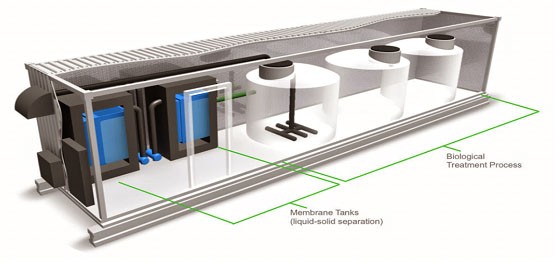A Sewage water treatment plant can be applied in big industries as well as at residential properties of the minuscule level. The plant installed at residential properties are for only a fewer number of people and so is known as a Domestic Sewage Water Treatment Plant. These plants are installed to prevent water scarcity in areas or properties currently facing one. Domestic sewage substantially includes the waste in the form of paper, food, wastewater of bathroom and sink, human waste and alike. It is necessary to remove all these waste before letting the wastewater out in the environment. The treated water won’t go to waste has it will be clean to reuse. This will help develop a sustainable and eco-friendly environment and will help to save water for our future generations.
Sewage water treatment plant can remove all major contaminations from water in spite of them being solid or really tiny. For this, the domestic plant follows a process to attain quality treated water.

1. Sedimentation
This is the primary stage of the water treatment process. In this stage, the water is released in the tanks for some period of time, allowing the solid waste to decompose at the bottom of the tank. This will result in a sludge that can be scraped off or pumped out into a separate facility, to be treated further. The tank will have oils and grease as residue, floating on top of the surface which can be easily removed.
2. Breaking Down of the Contaminants
The next stage after sedimentation involves breaking down of the contaminants. This is done by exposing the sludge to oxygen. This is a crucial biological process as it allows the bacterias to break down the contaminants. This may result in remains in solid nature. These can be assorted into two types of systems:
- Fixed Film Filtration- It uses a mix of filtrations and collects the remains on a growth medium.
- Suspended Growth Systems- It mixes the sludge with the microbes, such that the waste can be transformed into a solid state.
3. Improve the Quality of Water Through Sand Filtration
The third stage involves improving the quality of water through sand filtration. This achieved through a mix of techniques along with sand filtration. A unique step in this process lets the aquatic plant grow inside these waters, in order to remove remaining particles and excess phosphorus and nitrogen.
4. Disinfection
This is the last stage of a domestic sewage water treatment plant. In this stage, many disinfecting substances are added into the water in order to remove the remaining microorganisms. This step uses methods like chlorine light, ozone light, ultraviolet light, making the water ready to be returned into the environment.
Methods of Disinfection:
- Chlorine- Even though being the most common method used, Chlorine poses as a threat to our health.
- Ultraviolet- It is highly efficient in killing the bacterias but they might still remain in the water due to the presence of solids.
- Ozone- Ozone is the safest option but not many choose it as it is costly.
After this step, the sludge will be heated in this stage. This will make the water ready for agricultural processes by killing the remaining pathogens in the water.
Our wastewater includes several harmful infectious organisms that cause some serious damage to our eco-system around us and thus, harming us as well. Remove them all before they pollute the environment near you with a domestic sewage water treatment plant.
Choose the Leading Supplier of Sewage Treatment Plants in India!
Choose Cleantech Water to have a superior quality water treatment system for your home. We have a wide range of options, depending on your needs. Our plants are not only easy to maintain but are also cost-effective. Buy one today or inquire more by calling us at +91-9099915539!

